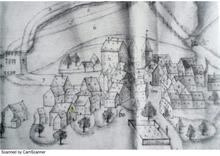Schwarzenfeld Castle
Schwarzenfeld Castle is a castle in Markt Schwarzenfeld and was the seat of the Counts of Holnstein from Bavaria. It was built in the 14th century and gained its final form in the 19th century in the architectural style of romantic historicism . It is the landmark of Schwarzenfeld.
history
The castle was built and inhabited by Conrad Pullenhofer in 1372 before it became the property of the Plankenfels family. These expanded the rather inconspicuous building and added four towers in the 15th century, which were probably destroyed during the Thirty Years War and have not been rebuilt since then.
In 1707 a fire destroyed the castle and the surrounding buildings, so that it had to be completely rebuilt elsewhere. A new building called the “Plankenfelser Schlössl” was built on the foundations of the former castle. It was adapted to the time with stepped gables. At the beginning of the 19th century, the main building was given its current shape by removing the stepped gable in favor of a hipped roof . Two small onion-tipped towers were also added.
1794 came the town Schwarzenfeld and therefore also the castle in the possession of the Counts of Holnstein and it was from the year 1857 by Count Maximilian Karl Theodor von Holnstein inhabited, known as Imperial Council, personal confidant and Oberststallmeister of the Bavarian King Ludwig II of Bavaria. A played an important role in the politics of that time in the Kingdom of Bavaria . Maximilian von Holstein was considered a friend of Prussia and was involved in the creation of the so-called Kaiserbrief , King Ludwig's approval for the establishment of the German Empire in 1871. In the years 1890 and 1892 he had Julius Hofmann expand the palace to include the outbuilding and the two towers in the style of the then popular architectural style of historicism. At times, up to 160 workers were involved in the renovation, which now gave the castle its final appearance. The surrounding buildings were also demolished to reveal the castle.
Shortly after completion, the count used the castle as a resting place. He died in 1895. His widow Maximiliane von Holnstein (born von Gumppenberg, 1850–1937) and his descendants only lived in the castle for a few years and after Countess Maximiliane moved out in 1907, the castle remained unused for a long time, except for brief leases. Economic and financial hardships forced Countess Maximiliane von Holnstein in 1936 to sell it to the National Socialist People's Welfare (NSV, Berlin).
Use after 1945
After the Second World War, the castle served for several years as an emergency shelter for displaced persons and refugees as well as temporary accommodation for school halls and as a retirement home. Further possibilities to use it in the long term failed for a long time. It was used as a dance hall, sewing shop and later as a riding hall.
The Schwarzenfeld market auctioned the property in 1954 with the premise "to preserve the castle for the market as a symbol of our homeland and not to let the external appearance change". Attempts to make the castle available as an office building for the state police or the Bavarian Red Cross were also unsuccessful. It often changed hands through various foreclosures before it was converted into a discotheque in 1979.
On the night of June 24th to 25th, 1982 the castle burned down completely, lay fallow for many years as a ruin and had to be renovated several times in order to preserve the building fabric. In 1995 it was sold to a private carrier who completely gutted it, renovated it and expanded the castle into a conference hotel , which opened in 1996. It bears the name Hotel Schloss Schwarzenfeld .
The Hofmarkschloss
In Schwarzenfeld there used to be the sinking Hofmarkschloss of the Hammer Schwarzenfeld .
literature
- Martin Irl, Peter Bartmann: Schwarzenfeld Castle and the legacy of the Counts of Holnstein from Bavaria. November 1996.
- Oswald Wilhelm: Chronicle Schwarzenfeld 1015–1990 . 1989.
Web links
- Entry on Schwarzenfeld Castle (New Castle) in the private database “All Castles”.
Individual evidence
- ^ Resolution of the Home and Beautification Association of March 27 and April 4, 1955
- ^ Entry on Schloss Schwarzenfeld (Hofmarkschloss) in the private database "Alle Burgen".
Coordinates: 49 ° 23 ′ 21.8 " N , 12 ° 8 ′ 29.4" E




